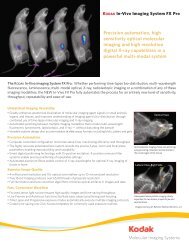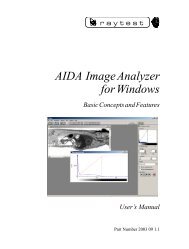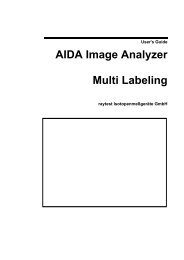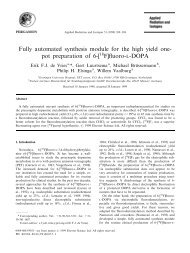Thin-Layer Radiochromatography - Raytest
Thin-Layer Radiochromatography - Raytest
Thin-Layer Radiochromatography - Raytest
You also want an ePaper? Increase the reach of your titles
YUMPU automatically turns print PDFs into web optimized ePapers that Google loves.
A Field Guide to In stru men ta tion<br />
Figure 2. BAS-5000 storage phosphor screen imaging<br />
system (courtesy of Fujifilm Life Science).<br />
multilabel dpm quench curves. The<br />
plastic Versa-Rack vial system allows<br />
counting of samples in any combination,<br />
up to 336 standard vials (20 mL) and<br />
648 miniature vials (6 mL); capabilities<br />
also exist to count 4 mL Bio-Vials and<br />
Microfuge tubes. Computer-based<br />
operation is via a combination of easy to<br />
use menus, context-sensitive help<br />
screens, and up to 50 user programs.<br />
Different biodegradable general use and<br />
specialized cocktails, plastic scintillation<br />
vials, unquenched LS standards, and<br />
quenched standards are among the<br />
available accessories.<br />
Phosphor Imaging<br />
Storage phosphor screen imaging is<br />
often termed filmless autoradiography.<br />
The phosphor screens are sensitive to<br />
any source of ionizing radiation, e.g.,<br />
14 C, 3 H, 35 S, 125 I, 32 P, 33 P, 18 F, and 99m Tc. They<br />
contain small crystals of a<br />
photostimulable phosphor coated on a<br />
support in which luminescence is<br />
produced and stored when exposed to<br />
radioactive TLC zones. The<br />
luminescence is evaluated by scanning<br />
with a laser in a reading device, and<br />
quantification is carried out by use of a<br />
calibration curve to exclude the effects<br />
of the phosphor screen type and<br />
exposure period. The screens can be<br />
reused after being erased by<br />
exposure to visible light. The<br />
formulation of the phosphor<br />
screen, chemistry of the detection<br />
process, mechanism of scanning,<br />
and software for evaluation of<br />
images may differ for instruments<br />
from each manufacturer.<br />
BAS-5000 Bioimaging<br />
Analyzer<br />
The BAS-5000 bioimaging<br />
analyzer from Fujifilm Life<br />
Science USA (Figure 2) uses a<br />
patented phosphor imaging plate (IP)<br />
with a scanner for IP reading for the<br />
sensitive, 2-dimensional (2D) detection<br />
of radioactive TLC zones by the<br />
photostimulated luminescence (PSL)<br />
phenomenon. The instrument features a<br />
confocal laser, light-collecting optics,<br />
dynamic range up to 5 orders of<br />
magnitude, and a pixel size as small as<br />
25 �m. A 20 � 25 cm IP with the images<br />
of chromatograms from a 20 � 20 cm<br />
TLC plate can be scanned at 50 �m in as<br />
manufacturing process. The exposed IP<br />
is scanned with a laser beam of red light<br />
(633 nm) focused by a mirror while<br />
being moved in the reader; the PSL<br />
released by the laser as photons of blue<br />
light (390 nm) is collected onto a PMT<br />
through a light collection guide and is<br />
converted to electrical signals.<br />
Cyclone Plus Phosphor Imager<br />
The PerkinElmer benchtop Cyclone<br />
Plus quantitative radiometric phosphor<br />
imager (Figure 3) operates with the same<br />
storage phosphor and scanning process<br />
(Figure 4), except that confocal optics<br />
and a helical scanning mechanism are<br />
used with the flexible phosphor screen<br />
loaded into a cylindrical carousel that<br />
spins at 360 rpm. This allows the<br />
instrument to be more compact and less<br />
expensive than the BAS-5000, in which<br />
the phosphor screen is kept on a flat<br />
plane during scanning. The phosphor<br />
screen is scanned by the system’s laser<br />
focused to less than 50 �m, and the latent<br />
image is detected by the instrument<br />
optics to create a high-resolution<br />
digitized image of the layer with<br />
quantitative data in the form of an image<br />
file. The image is displayed on the<br />
computer screen for analysis with<br />
OptiQuant software and can be printed,<br />
exported, and archived for future use.<br />
The following storage phosphor screens<br />
little as 5 min; the detection limit is<br />
0.11 dpm/mm 2<br />
/h for P 32<br />
. Compared to<br />
X-ray film, sensitivity is about 100 times<br />
higher, processing is 10–100 times<br />
faster, and quantitative accuracy is<br />
greater.<br />
The IP consists of 5 �m crystals of<br />
barium fluorobromide containing a trace<br />
amount of bivalent europium<br />
(BaFBr:Eu +2 ) as a<br />
bioluminescence center<br />
coated on a polyester support<br />
film. When the crystal is<br />
exposed to a radiolabeled<br />
zone, the energy of the<br />
radioisotope ionizes the Eu +2<br />
to Eu +3<br />
, liberating electrons<br />
to the conduction band of the<br />
phosphor crystals. The<br />
electrons are trapped in the<br />
bromine vacancies Figure 3. Cyclone Plus phosphor imager (courtesy of<br />
introduced during the<br />
PerkinElmer).<br />
JOURNAL OF AOAC INTERNATIONAL VOL. 92, NO. 1, 2009. � Copyright 2009 by AOAC INTERNATIONAL. Reprinted with permission.









